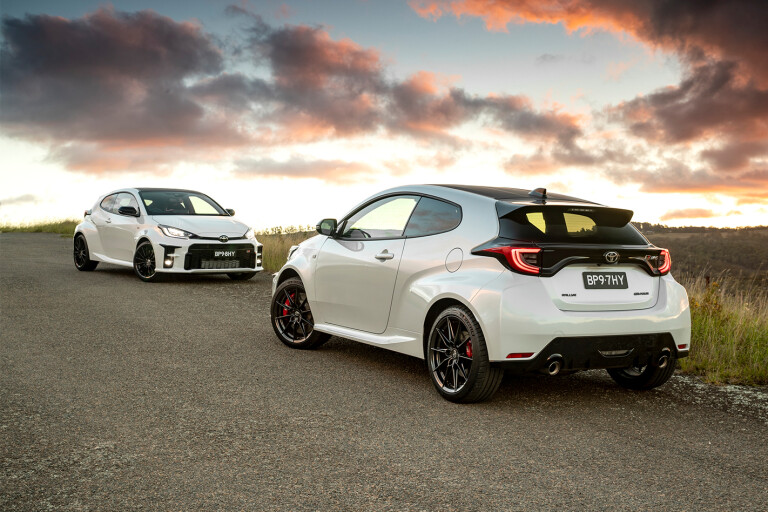
It takes a big person to admit that they’re wrong and an even bigger company, but it’s thanks to just such a capitulation that Australia now welcomes the Toyota GR Yaris Rallye.
At the international launch of the GR Yaris Toyota Australia’s Vice President of Sales and Marketing, Sean Hanley, told media: “The [standard] GR Yaris…ticks every box we needed to tick to bring this car to market in Australia.”
Cleverly, Hanley did leave himself an out clause, saying: “Of course, in the event that we get overwhelming market demand we can always look at the option pack going forward” and here we are. Having seen and heard the outcry from Australian enthusiasts about being denied the ultimate GR Yaris, Toyota decided the base GR Yaris didn’t actually tick every box and introduced the Performance Pack, known locally as the Rallye.
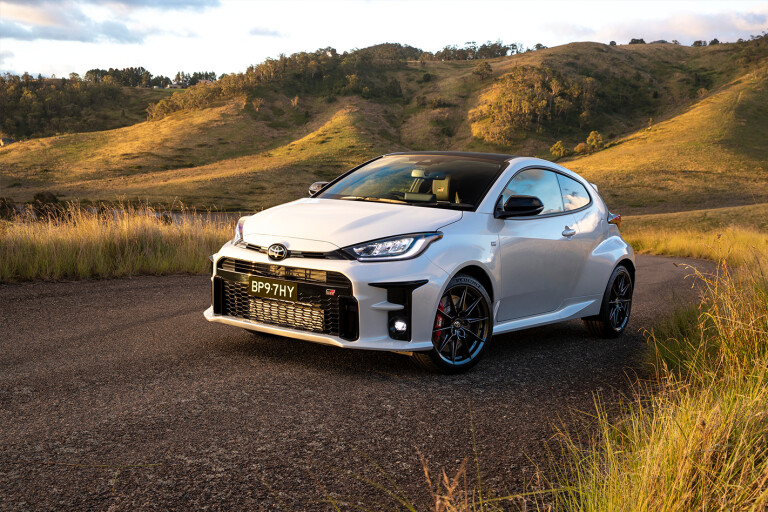
The name is a nod to Toyota’s last homologation special, its last all-wheel drive turbo model and, really, its last real wholly-developed performance car, the Celica GT-Four (the 86 being a joint venture with Subaru and the Supra a partnership with BMW).
Each locally-sold GR Yaris Rallye will be individually numbered, though it’s not a limited production model per se; those numbers could go up to 250 or 670 or 12,367 if they sell enough of them. Toyota continued its unusual but successful GR Yaris pricing strategy with the Rallye, the first 200 cars being offered at $56,200 driveaway, which were quickly snapped up, before reverting to an RRP of $54,500 before on-roads, a $5000 premium over the standard model.
Driveaway pricing will obviously depend on your state, but Toyota’s website suggests driveaway pricing of $59,637 in Melbourne, $59,173 in Sydney, $58,734 in Brisbane, $59,196 in Adelaide and $60,724 in Perth. You can be confident in those prices, too, as there are no options, every car being painted in the same Rallye-specific Frosted White crystal pearl.
Despite the obvious performance potential, Toyota’s standard five-year, unlimited-kilometre warranty applies, as does the seven-year extended warranty for the engine and driveline. Capped price servicing limits the spend to $260 for each of the first six services, but they are required every six months or 10,000km.
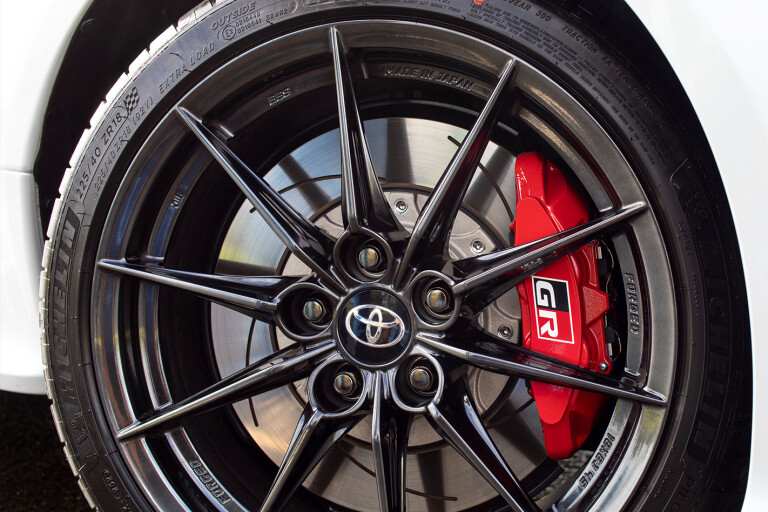
The easiest way to differentiate a Rallye is the badge on its rear hatch, but otherwise there are 18-inch forged BBS alloy wheels, brake ducts either side of the front grille, Michelin Pilot Sport 4 S tyres and red brake calipers. Inside there are sports front seats with red stitching and Ultrasuede inserts, as well as that numbered plaque on the centre console.
Hidden away out of sight is uprated suspension and a Torsen limited-slip differential at either end. These differentials allow the torque to be split left-to-right across each axle to the tyre with the most traction, in addition to the electronically controlled multi-plate clutch integrated into the rear diff which apportions the torque front to rear.
There are three drive modes that alters the basic torque split, though it’s almost constantly varying in response to driving conditions. Normal is 60:40 front-to-rear, Sport is a rear-biased 30:70 and Track an even 50:50.

Toyota laid on the Sutton Road driver training complex in Canberra for the Rallye launch with access to its tight, challenging hill course and a motorkhana-style test on its sodden skidpan. To be honest around the former the differences between the standard car and the Rallye were slight; it’s a circuit that plays to the GR Yaris’s strengths and with ESP fully on any potential wheel slip was mopped up by the traction control before the diffs could really take over.
There was definitely greater front end purchase courtesy of the Michelin tyres – the standard GR Yaris wears Dunlop SP Sport Maxxes – and with greater familiarity and confidence quick changes of direction were dealt with more accurately by the Rallye, the standard car feeling to float momentarily as it attempted to control its weight.
A proper upcoming test on track will allow a more in-depth examination of the dynamics of the Rallye’s suspension modifications, which include larger diameter springs, a thicker anti-roll bar and stiffer bushes at the front plus stiffer bushes and bearings and two pillow-ball joints in the rear. Time on the road was brief, but the changes have happily had little to no effect on the GR Yaris’s ride quality.
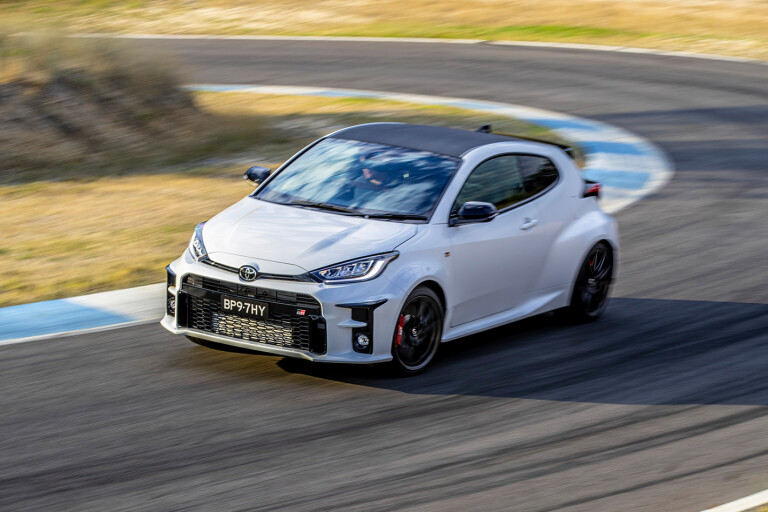
Surprisingly, it’s the wet motorkhana where the Rallye comes alive. What was expected to be an opportunity to skid around and kill a few witches’ hats was actually an illuminating demonstration in the efficacy of proper limited-slip differentials.
The standard GR Yaris was fun, no doubt, pirouetting around the cones with a dab of handbrake and plenty of throttle but, should the wheels encounter different levels of grip, the wheel on the slipperier surface – usually the unladen inside front – would spin freely and have the engine smacking into the rev limiter.
In contrast, the Rallye would spin all four wheels virtually in concert, keeping the revs hanging steady and making the slide more controllable and, crucially, more enjoyable. Not necessarily the most consumer-relevant test, but a big tick for the diffs nonetheless.
This alone makes the Rallye worth the extra. If you’re going to spend $50K plus on a GR Yaris, you might as well spend a little extra and get the ‘good’ one, for the Rallye does feel to fulfil the car’s potential to a greater extent.

The rest of the package, good and bad, is as per the standard GR Yaris. The engine remains a thing of wonder, its power, torque and response completely at odds with both its capacity and its cylinder count. It seriously hauls and the six-speed manual is a good shift with short ratios that makes the most of the grunt, though the auto-blip function is a long way from the best around, being far too slow to rev-match on downchanges.
Inside is where the GR Yaris struggles most. It’s reasonably well equipped, with dual-zone climate, keyless entry and start, a 7.0-inch touchscreen multimedia system, eight-speaker JBL stereo, a head-up display, six airbags and a raft of active safety equipment including active cruise control, road sign assist, intersection assistance, blind-spot monitoring and more, but a lot of the trim is made from hard, scratchy plastic.
Thankfully the bits you interact with as a driver, specifically the steering wheel and gearshift, are leather-wrapped and the seat isn’t set as high as memory serves – you do get used to the elevated perch. The rear seats are all but useless – small children would fit, but getting them in there is a different matter – and the 141-litre boot is hilariously small, but treat the GR Yaris as a strict two-seater by folding the rear seats and it turns into a miniature van with 737 litres of cargo space.
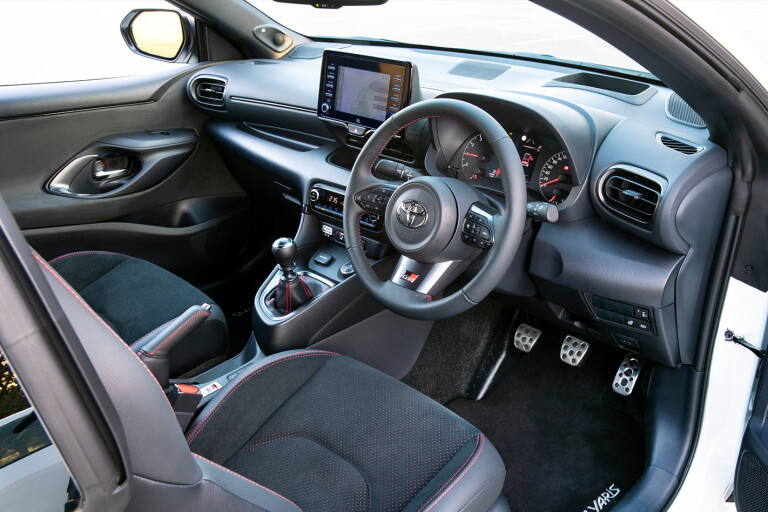
You also score all the cool bits that Tommi Makinen insisted on for the – sadly stillborn – Yaris World Rally Car, like the aerodynamically-optimised sloping carbon roof, aluminium doors, hatch and bonnet, stiff three-door body shell and half-Yaris, half-Corolla platform.
All in all, the GR Yaris Rallye is an improvement over the standard car. Just how much of an improvement needs a longer test on road and track, but it certainly feels to be the car the GR Yaris was always meant to be: more capable, more exclusive, more fun.
The price remains a problem, though. I think back to the Ford Focus RS Limited Edition, a car that was as quick in a straight line, more entertaining to drive, had true five-door practicality, a Quaife limited-slip diff in the nose and Michelin Pilot Sport Cup 2 tyres.
It lapped Winton 5.4sec quicker than the GR Yaris and that was before the circuit modifications that shaved 1-1.5sec from lap times; even the standard Focus RS was 2.9sec quicker. And both Fords set virtually identical straight-line numbers to the Toyota, so it’s all in the corners.
Toyota deserves a lot of kudos for building such an enthusiast-focused product AND bringing it to market, but in such a fiercely competitive hot hatch market, with pint-sized heroes like the Ford Fiesta and Hyundai i20 N or more serious contenders like the Honda Civic Type R and new VW Golf R, the GR Yaris’s price/performance ratio struggles to stand out.
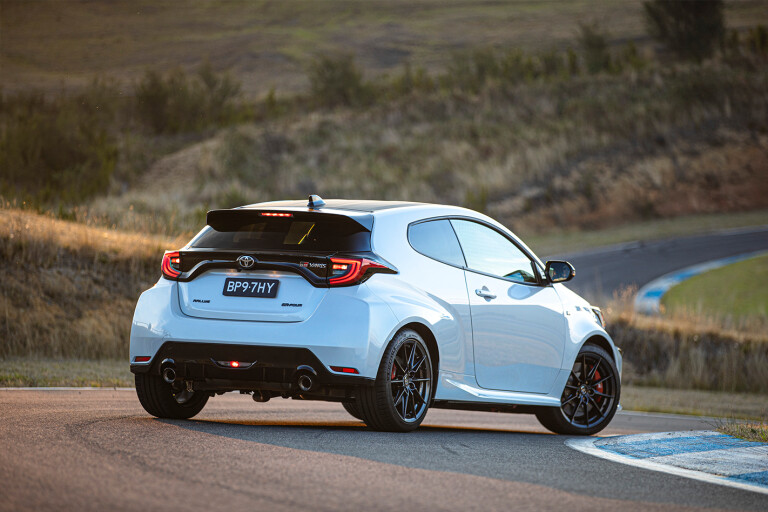
Verdict: 8.0/10
Likes: improved handling; more exclusive; fulfils potential
Dislikes: even more expensive; seat too high; practicality issues
Specifications
Body: 3-door, 4-seat hatch
Drive: all-wheel
Engine: 1618cc inline-3cyl, DOHC, 12v, turbocharger
Bore/stroke: 87.5 x 89.7mm
Compression: 10.5:1
Power: 200kW @ 6500rpm
Torque: 370Nm @ 3000-4600rpm
0-100km/h: 5.2sec (claimed)
Fuel consumption: 7.6L/100km (combined/claimed)
Top Speed: 230km/h (claimed)
Weight: 1280kg
Power/weight: 156kW/tonne
Transmission: 6-speed manual
Suspension: struts, coil springs, anti-roll bar (f); multi-links, coil springs, anti-roll bar (r)
L/W/H: 3995/1805/1455mm
Wheelbase: 2560mm
Tracks: 1535/1565mm
Steering: electrically assisted rack-and-pinion
Brakes: 356mm ventilated discs, 4-piston calipers (f); 297mm ventilated discs, 2-piston calipers
Wheels: 18 x 8.0-inch (f/r)
Tyres: 225/40 ZR18 (f/r) Michelin Pilot Sport 4 S
Price: $54,500

COMMENTS